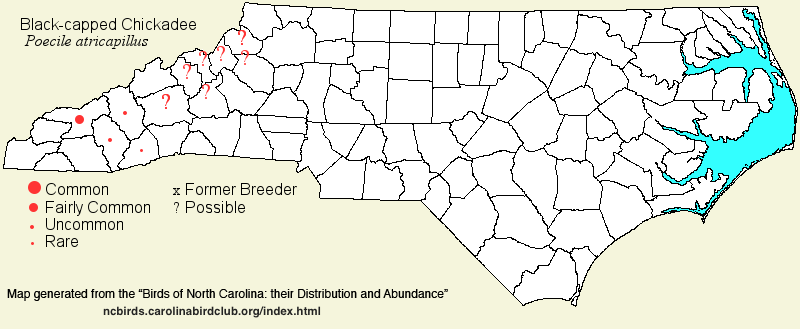 |  |
|
Black-capped Chickadee - Poecile atricapillus PARIDAE Members: | Search Common: Search Scientific: |
|
|
||||||
| General Comments | The Black-capped Chickadee is one of the most common and familiar species to people in Canada and the northern portions of the United States, but in North Carolina, one must normally travel to the Great Smoky Mountains NP, or the southwestern end of the Blue Ridge Parkway, to find a Black-capped Chickadee. In the national park, it is somewhat widespread at the higher elevations, even in hardwoods; however, it is restricted to the spruce-fir stands, or where mixed with some hardwoods, farther southeast toward the right-angle bend in the Parkway, near Devils Courthouse. In fact, chickadees at this southeastern end of the state range seem to have some characters of the very similar Carolina Chickadee; thus, the husky "chick-a-dee-dee-dee" call heard in the Smokies is often replaced by a less husky and higher call at the end of the range (and therefore closer to a Carolina call). However, the song of these "iffy" birds is the two- or three-note "fee-bee" or "fee-bee-bee" whistle of the Black-capped, though seemingly higher-pitched than in the Smokies. (Carolina's song is clear four-note "fee-bee fee-bay", quite different from the Black-capped song). Thus, these birds have probably rightly been called Black-capped Chickadees. This southern Appalachian range is quite disjunct from the rest of the range, from central Virginia northward. Thus, the species is surprisingly absent from the spruce-fir forests on Mount Rogers, VA, and Grandfather Mountain, Roan Mountain, and the Black Mountains in NC. Nonetheless, there are a few records from each of these ranges in the summer, most made by experienced observers; however, there are no nesting records from these areas, and these must be considered of strays. Black-capped Chickadees are somewhat migratory, and they occur sparingly in the VA Piedmont in winter, where they do not nest. Thus, some of these strays could have been winter migrants that stayed into the nesting season. | |||||
| Breeding Status | Breeder | |||||
| NC BRC List | Definitive | |||||
| State Status | SC | |||||
| U.S. Status | ||||||
| State Rank | S3 | |||||
| Global Rank | G5 | |||||
| Coastal Plain | No records. | |||||
| Piedmont | No confirmed records. There are the occasional reports of "Black-capped Chickadees" from the province, but these are generally made by inexperienced observers. As noted above, the species is partially migratory, and birds do occur in some areas in VA in winter where they do not breed. Thus, a rare winter stray in the Piedmont of NC would be possible. However, photos and/or recordings would be needed to confirm a first record for the province. | |||||
| Mountains | Permanent resident, apparently with no migratory movements (though birds do move slightly down-slope in winter), only conclusively in the southwestern portion of the province. Fairly common above about 4,500 feet in Great Smoky Mountains NP; uncommon farther southeastward to Devils Courthouse, not far from the spine of the Great Balsams (and the Blue Ridge Parkway), mostly above 5,000 feet (or at least where there are spruce-fir stands). Essentially absent elsewhere at all seasons, though there are sporadic reports (likely misidentifications?). There are several scattered records for Grandfather Mountain, Roan Mountain, and the Mount Mitchell area; plus a count of four birds along the Blue Ridge Parkway near Asheville, at 3,600 feet, on 17 Dec 1989. These records northeast of Devils Courthouse must be considered as strays, very rare winter visitors, etc. There have been no consistent summer reports from these sites, despite excellent nesting habitat. Peak counts: | |||||
| Finding Tips |
If you are coming from most of the state to look for the species, stop first at overlooks along the Blue Ridge Parkway starting at Devils Courthouse, and walk any trails or along the parkway. Your best best, however, is the Heintooga Road, at the southeastern edge of Great Smoky Mountains NP. Stop anywhere along the road where there are spruce-fir stands. This road normally has little traffic, and seldom fails to produce the birds. You shouldn't have to brave traffic jams along the busy US 441 to reach Newfound Gap or Clingmans Dome to find a chickadee. *** | |||||
| Attribution | LeGrand[2024-08-06], LeGrand[2023-03-26], LeGrand[2018-12-19] | |||||
| NC Map Map depicts all counties with a report (transient or resident) for the species. | Click on county for list of all known species. |
| NC Breeding Season Map Map depicts assumed breeding season abundance for the species. |  |